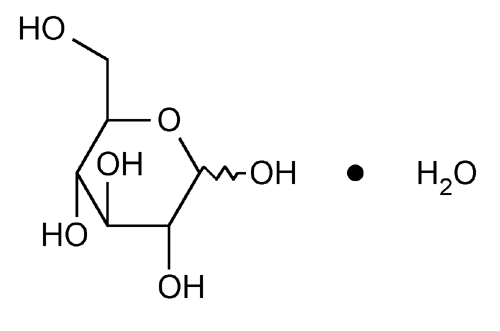Dextrose
d-Glucose, monohydrate.
d-Glucose monohydrate
Anhydrous 180.16
» Dextrose is a sugar usually obtained by the hydrolysis of starch. It contains one molecule of water of hydration or is anhydrous.
Packaging and storage—
Preserve in well-closed containers.
Labeling—
Label it to indicate whether it is hydrous or anhydrous.
Identification—
Add a few drops of a solution (1 in 20) to 5 mL of hot alkaline cupric tartrate TS: a copious red precipitate of cuprous oxide is formed.
Color of solution—
Dissolve 25 g in water to make 50.0 mL of solution: the solution has no more color than a solution prepared by mixing 1.0 mL of cobaltous chloride CS, 3.0 mL of ferric chloride CS, and 2.0 mL of cupric sulfate CS with water to make 10 mL, and diluting 3 mL of this solution with water to 50 mL. Make the comparison by viewing the solutions downward in matched color-comparison tubes against a white surface.
Specific rotation  781S
781S :
between +52.6
:
between +52.6 and +53.2
and +53.2 .
.
Test solution:
100 mg per mL, in 0.012 N ammonium hydroxide.
Acidity—
Dissolve 5.0 g in 50 mL of carbon dioxide-free water. Add phenolphthalein TS, and titrate with 0.020 N sodium hydroxide to the production of a distinct pink color: not more than 0.30 mL is required for neutralization.
Water, Method III  921
921 —
Dry it at 105
—
Dry it at 105 for 16 hours: the hydrous form loses between 7.5% and 9.5% of its weight, and the anhydrous form loses not more than 0.5% of its weight.
for 16 hours: the hydrous form loses between 7.5% and 9.5% of its weight, and the anhydrous form loses not more than 0.5% of its weight.
Residue on ignition  281
281 :
not more than 0.1%.
:
not more than 0.1%.
Chloride  221
221 —
A 2.0-g portion shows no more chloride than corresponds to 0.50 mL of 0.020 N hydrochloric acid (0.018%).
—
A 2.0-g portion shows no more chloride than corresponds to 0.50 mL of 0.020 N hydrochloric acid (0.018%).
Sulfate  221
221 —
A 2.0-g portion shows no more sulfate than corresponds to 0.50 mL of 0.020 N sulfuric acid (0.025%).
—
A 2.0-g portion shows no more sulfate than corresponds to 0.50 mL of 0.020 N sulfuric acid (0.025%).
Arsenic, Method I  211
211 :
1 ppm.
:
1 ppm.
Heavy metals  231
231 —
Dissolve 4.0 g in water to make 25 mL of solution: the limit is 5 ppm.
—
Dissolve 4.0 g in water to make 25 mL of solution: the limit is 5 ppm.
Dextrin—
Reflux 1 g of finely powdered Dextrose with 20 mL of alcohol: it dissolves completely.
Soluble starch, sulfites—
To a solution of 1 g in 10 mL of water add 1 drop of iodine TS: the liquid is colored yellow.
Auxiliary Information—
Please check for your question in the FAQs before contacting USP.
Chromatographic Column—
| Topic/Question | Contact | Expert Committee |
| Monograph | Daniel K. Bempong, Ph.D.
Senior Scientist 1-301-816-8143 |
(MDPS05) Monograph Development-Pulmonary and Steroids |
USP32–NF27 Page 2107
Pharmacopeial Forum: Volume No. 34(6) Page 1585
Chromatographic columns text is not derived from, and not part of, USP 32 or NF 27.
